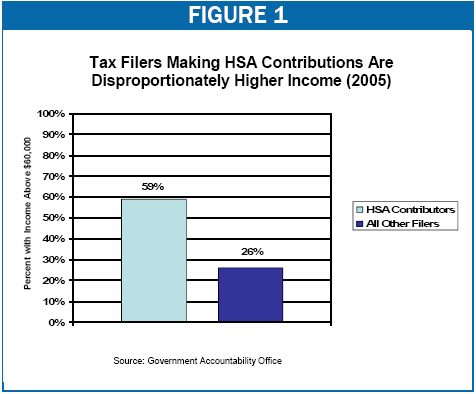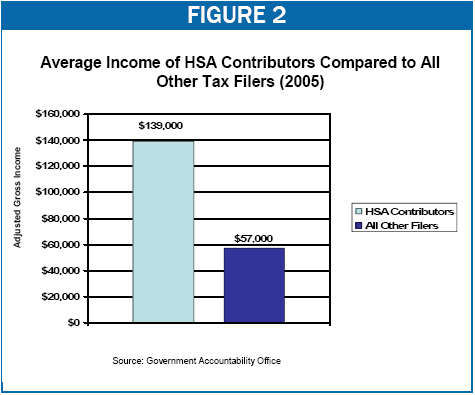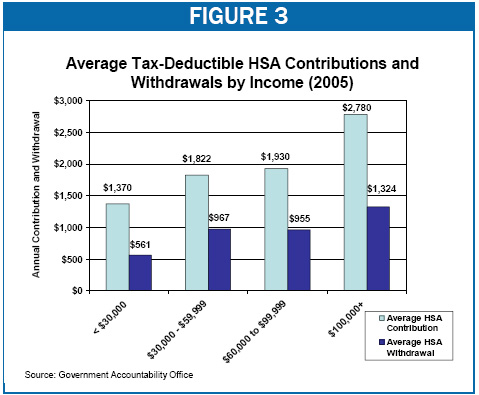|
May 19, 2008
GAO STUDY AGAIN CONFIRMS HEALTH SAVINGS ACCOUNTS
PRIMARILY BENEFIT HIGH-INCOME INDIVIDUALS
By Edwin Park
A
new Government Accountability Office (GAO) report indicates that Health Savings
Accounts are used disproportionately by affluent households. Its findings also
suggest that HSAs are being used extensively as tax shelters.
What Are Health Savings Accounts and Why Are They Attractive as
Tax Shelters?
Established by the 2003 Medicare drug legislation, Health Savings Accounts
(HSAs) are accounts in which individuals with a high-deductible health insurance
policy can save money to pay for out-of-pocket health expenses. In tax year
2008, someone who enrolls in a health plan with a deductible of at least $1,100
for individual coverage and $2,200 for family coverage may establish an HSA.

HSA contributions are tax deductible. In 2008, individuals may contribute
up to $2,900 for individual coverage and $5,800 for family coverage. These
tax-preferred contributions may be placed in stocks, bonds, or other investment
vehicles, with the earnings accruing tax free. Withdrawals also are tax
exempt if used for out-of-pocket medical costs.
HSAs thus have a unique tax structure. No other savings vehicle in the federal
tax code offers both tax-deductible contributions and tax-free
withdrawals, as HSAs do. Moreover, because the value of a tax deduction
rises with an individual’s tax bracket, HSAs provide the largest tax benefits to
high-income individuals. In addition, higher-income individuals generally
can afford to contribute more money into HSAs each year than lower-income
people. And since there are no income limits on HSA participation, very
affluent individuals whose incomes who are too high for them to qualify for IRA
tax breaks, or who have “maxed out” their 401(k) contributions, can use HSAs to
shelter additional funds.

As a result, many health and tax policy analysts
have warned that HSAs are likely to be used extensively as tax shelters by
high-income individuals. The Bush Administration and other HSA proponents
have repeatedly dismissed this concern and argued that HSAs will not have such
effects.
What the GAO Report Shows
About HSA Use
In
2006, the GAO issued a groundbreaking study analyzing, for the first time, data
from the Internal Revenue Service on all Americans who made HSA contributions in
tax year 2004.
The study also examined three large employers who offered HSA-eligible high
deductible plans, as well as data on enrollment in HSA-eligible plans from
several national surveys of employers. In that report, the GAO determined that
tax filers who make contributions to HSAs were disproportionately high-income
individuals, and that among HSA users, those with high incomes made the largest
contributions and received the largest tax benefits. The GAO also found initial
indications that HSAs are being used as tax shelters.

The GAO’s new report on the use of Health Savings Accounts examines IRS data for
tax year 2005, as well as employer surveys. The findings bolster those from the
GAO’s earlier study.
The new report’s principal findings include:
- HSA participants are
disproportionately high-income. In tax year 2005, some 59 percent of tax
filers making HSA contributions
had adjusted gross income of $60,000 or more, even though only 26 percent of all
other adult tax filers under age 65 had incomes this large (see Figure 1). At
the other end of the income scale, people with adjusted gross income of less
than $30,000 made up 50 percent of all other tax filers in 2005 but only 15
percent of all HSA participants.
The average adjusted gross income of tax filers who made HSA contributions in
2005 was $139,000, as compared to $57,000 for all other tax filers under age 65
(see Figure 2).
- Affluent HSA participants
contribute much more to the accounts than other participants. HSA
participants with incomes over $100,000 contributed an average of $2,780 to
their accounts in 2005, as compared to an average contribution of $1,370 for HSA
participants with incomes below $30,000 (see Figure 3). The fact that
higher-income individuals not only are more likely to have HSAs but also
contribute more to their accounts further skews the tax benefits of HSAs to
high-income households, as does the fact that the higher one’s tax bracket, the
greater the subsidy that HSAs provide.
- Many HSA participants appear to be
using their accounts purely or primarily as a tax shelter rather than paying for
out-of-pocket health care costs. The GAO found that a stunning 41 percent
of tax filers reporting HSA contributions in 2005 did not withdraw any
funds from their accounts at any time during the year.
In recent Congressional testimony, the GAO stated that this was consistent with
the view held by industry experts that many HSA users are people who primarily
use their HSAs as a tax-advantaged savings vehicle.
Overall, the average HSA contribution in 2005 was $2,100, more than double the
average HSA withdrawal of $1,000. As one would expect, tax filers with
incomes over $100,000 had the largest net contributions to their HSA
contributions, contributing an average of $2,780 and withdrawing an average of
$1,324 in 2005, for a net increase in their HSA balance of $1,456 (see Figure
3).
-
Many employers offering
high-deductible health insurance plans and HSAs did not contribute to
their workers’ HSAs. The GAO reported that a series of employer
surveys conducted in 2005, 2006 and 2007 found that more than one-third of large
employers offering HSA-eligible plans made no contribution to their employees’
HSAs. GAO also cited another survey finding that nearly half of small and
large employers offering high-deductible plans made no HSA contributions for
their employees in 2007. This may mean that some lower-income workers who
cannot make substantial HSA contributions on their own, and whose employers make
no contributions on their behalf, may be unable to afford the high deductibles
required under HSA-eligible plans when they or their families need health care.
Health and tax policy analysts have long warned that HSAs could be used
extensively as tax shelters by high-income individuals. The GAO’s latest
analysis of HSAs again lends strong credence to these concerns.
End Notes:
Government
Accountability Office, “Health Savings Accounts: Participation Increased and
Was More Common among Individuals with Higher Incomes,” April 1, 2008.
Government
Accountability Office, “Consumer-Directed Health Plans: Early Enrollee
Experiences with Health Savings Accounts and Eligible Health Plans,” August
8, 2006.
See Government
Accountability Office (2006), op cit and Edwin Park and Robert
Greenstein, “GAO Study Confirms Health Savings Accounts Primarily Benefit
High-Income Taxpayers,” Center on Budget and Policy Priorities, September
20, 2006.
Government
Accountability Office (2008), op cit.
Contributions
include those made by individual tax filers as well as those made by
employers or other individuals on their behalf, but do not include funds
transferred from Medical Savings Accounts, precursors to Health Savings
Accounts that are established as part of a demonstration project in 1996.
It is likely
that there are a number of individuals in this income range who may be
enrolled in HSA-eligible high-deductible health plans but have not
established or contributed to a HSA. According to GAO’s examination of
employer surveys, more than 40 percent of individuals enrolled in a
high-deductible health insurance plan eligible for a HSA did not open an
HSA. Reasons cited by survey respondents included lack of information, lack
of need and a belief that they could not afford to put money in the
accounts. Government Accountability Office (2008), op cit.
Health policy
analysts and economists have expressed significant concern that
high-deductible plans attached to HSAs risk “adverse selection.” Adverse
selection occurs when healthy and less-healthy individuals separate into
different health insurance arrangements, and the average cost of insurance
for the less-healthy group rises significantly, because these people are no
longer being pooled with healthier individuals who are less expensive to
insure. When that occurs, premium costs for the less-healthy can rise
sufficiently high that those individuals are put at risk of becoming
uninsured or underinsured.
High deductible plans attached to HSAs are
likely to be disproportionately attractive to healthier individuals who do
not need much health care and thus are less concerned about the higher
out-of-pocket costs that can result under a high-deductible plan in
comparison to a more traditional lower-deductible plan. If healthier
individuals move to HSA-eligible plans in large numbers over time while less
healthy individuals remain in traditional plans, that could drive up health
insurance premiums for the more traditional plans and make them increasingly
unaffordable over time. The fact that a large proportion of individuals
contributing to HSAs make no withdrawals may indicate not only that these
individuals are using HSAs as tax shelters but also that they may be
healthier, on average, and therefore have less utilization of health care
services. This deepens the concern over adverse selection. For a
discussion of why Health Savings Accounts may spur adverse selection, see
Edwin Park and Robert Greenstein, “Latest Enrollment Data Still Fail to
Dispel Concerns About Health Savings Accounts,” Center on Budget and Policy
Priorities, Revised January 30, 2006.
John Dicken,
“Health Savings Accounts: Participation Grew, and Many HSA-Eligible Plan
Enrollees Did Not Open HSAs while Individuals Who Did Had Higher Incomes,”
Testimony before the Subcommittee on Health, House Ways and Means Committee,
Government Accountability Office, May 14, 2008. The GAO also noted that
only 22 percent of tax filers making HSA contributions withdrew as much or
more than their reported contributions. According to the GAO, industry
experts viewed this minority population as consistent with HSA account
holders who are “spenders” and who actually use these accounts to pay for
out-of-pocket health care costs, rather than as a tax-preferred savings
vehicle.
|